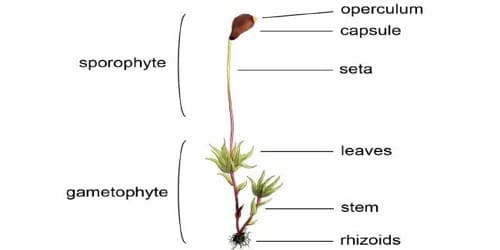Gametophyte of moss: Gametophyte of moss plant is haploid (n). Its body is divided into two stages.
(I) Protonema, and,
(II) Gametophore
Protonema: Spores produced from the moss capsule germinate in favorable conditions. Spores germinate to form a filamentous, branched and algae-like plant, called protonema.
Gametophore: The part of the protonema developed erectly and enriched with leaves is known as gametophore protonema dies after the gametophore becomes fully developed.
At the matured stage, protonema has three parts
(a) Stem: It is slender flexible and branched or unbranched.
(b) Leaf: Leaves are simple and spirally arranged in the stem. Each leaf has a single midrib.
(c) Rhizoid: The hairy filaments growing in a cluster from the underground part of the stem are known as rhizoids. They are slender, branched, and multicellular and have oblique septa. They arise from the base of the axis.
Rhizoids instead of roots, fix the plant firmly with the soil and absorb water and mineral.

Mosses are bryophytes and have no proper stem or roots. It has two parts sporophyte and gametophyte. The sporophyte stalk, called the seta, bears the spore capsule on its tip. The capsule top ruptures and falls off to discharge mature spores for producing new plants. Gametophyte contains balls of unspecialized cells called gammae. It breaks to form a protonema that sends out lateral shoots. A gametophyte represents the sexual phase of plant life. The gametophyte refers to all organs and tissues that are a part of the haploid generation.
The adult gametophyte is differentiated into rhizoids, axis or ‘stem’ and ‘leaves’. The term gametophyte might refer to the gametophyte phase of the plant life cycle or to the exacting plant body or organ that produces gametes. They are the most conspicuous part of the moss. For instance, most mosses have spirally arranged leaves that are one cell layer thick (unistratose).











